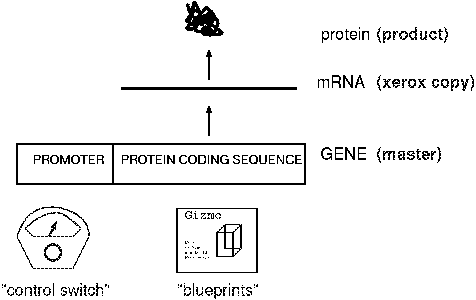Most genes encode the instructions for producing a protein. In the cell, proteins called enzymes carry out most of the biochemical reactions that underlie life. Other proteins serve structural roles.

Genes have two main parts. The protein coding sequence contains the structural blueprints for the protein. If the cell was a factory, the gene would be the master copy of a blueprint for a product. In our imaginary factory, thousands of xerox copies are made (messenger RNA, or mRNA), and handed out to the workers. Each worker uses their copy of the instructions to make thousands of copies of the product.
Equally important, the promoter controls when, where, and to what degree a gene is turned on. Like the volume control on a radio, the more highly expressed the gene is, the more copies of the mRNA are produced, hence the more copies of the protein product. The promoter may also contain instructions that limit the expression to specific tissues or organs (eg. seeds, leaves, roots) or in response to specific stimuli (eg. red light, fungi, heat stress).
The plant genome contains thousands of genes. Together, the proteins encoded by the genome, and the instructions for expression, will determine how a plant grows and reproduces. We can now create synthetic genes, in which the protein coding sequence for a gene we wish to express is linked to a promoter that governs when and where in the plant the gene is turned on.
 previous page
previous page
 next page
next page